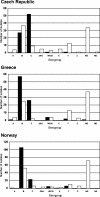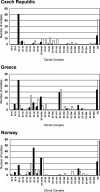Distribution of serogroups and genotypes among disease-associated and carried isolates of Neisseria meningitidis from the Czech Republic, Greece, and Norway
- PMID: 15528708
- PMCID: PMC525265
- DOI: 10.1128/JCM.42.11.5146-5153.2004
Distribution of serogroups and genotypes among disease-associated and carried isolates of Neisseria meningitidis from the Czech Republic, Greece, and Norway
Abstract
The distribution of serogroups and multilocus sequence types (STs) in collections of disease-associated and carried meningococci from the period 1991 to 2000 in three European countries (the Czech Republic, Greece, and Norway) was investigated. A total of 314 patient isolates and 353 isolates from asymptomatic carriers were characterized. The frequency distributions of serogroups and clone complexes differed among countries and between disease and carrier isolate collections. Highly significant differentiation was seen at each housekeeping locus. A marked positive association of serogroup C with disease was evidenced. The ST-11 complex was strongly positively associated with disease; associations for other clone complexes were weaker. The genetic diversity of the clone complexes differed. A single ST dominated the ST-11 clone complex, while the ST-41/44 complex exhibited greater levels of diversity. These data robustly demonstrated differences in the distribution of meningococcal genotypes in disease and carrier isolates and among countries. Further, they indicated that differences in genotype diversity and pathogenicity exist between meningococcal clone complexes.
Figures


References
-
- Abdillahi, H., and J. T. Poolman. 1988. Typing of group-B Neisseria meningitidis with monoclonal antibodies in the whole-cell ELISA. J. Med. Microbiol. 26:177-180. - PubMed
-
- Bevanger, L., K. Bergh, G. Gisnas, D. A. Caugant, and L. O. Frøholm. 1998. Identification of nasopharyngeal carriage of an outbreak strain of Neisseria meningitidis by pulsed-field gel electrophoresis versus phenotypic methods. J. Med. Microbiol. 47:993-998. - PubMed
-
- Broome, C. V. 1986. The carrier state: Neisseria meningitidis. J. Antimicrob. Chemother. 18(Suppl. A):25-34. - PubMed
Publication types
MeSH terms
LinkOut - more resources
Full Text Sources
Other Literature Sources
Medical

